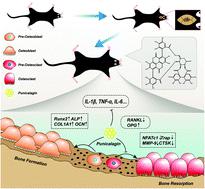当前位置:
X-MOL 学术
›
Biomater. Sci.
›
论文详情
Our official English website, www.x-mol.net, welcomes your feedback! (Note: you will need to create a separate account there.)
Punicalagin ameliorates wear-particle-induced inflammatory bone destruction by bi-directional regulation of osteoblastic formation and osteoclastic resorption.
Biomaterials Science ( IF 6.6 ) Pub Date : 2020-08-18 , DOI: 10.1039/d0bm00718h Qing Wang 1 , Gaoran Ge , Xiaolong Liang , Jiaxiang Bai , Wei Wang , Wenhao Zhang , Kai Zheng , Sen Yang , Minggang Wei , Huilin Yang , Yaozeng Xu , Boling Liu , Dechun Geng
Biomaterials Science ( IF 6.6 ) Pub Date : 2020-08-18 , DOI: 10.1039/d0bm00718h Qing Wang 1 , Gaoran Ge , Xiaolong Liang , Jiaxiang Bai , Wei Wang , Wenhao Zhang , Kai Zheng , Sen Yang , Minggang Wei , Huilin Yang , Yaozeng Xu , Boling Liu , Dechun Geng
Affiliation

|
Periprosthetic osteolysis (PPO) and subsequent aseptic loosening are the main causes of implant failure and revision surgery. Emerging evidence has suggested that wear-particle-induced chronic inflammation, osteoblast inhibition and osteoclast formation at the biointerface of implant materials are responsible for PPO. Punicalagin (PCG), a polyphenolic compound molecularly extracted from pomegranate rinds, plays a critical role in antioxidant, anticancer and anti-inflammatory activities. However, whether PCG could attenuate chronic inflammation and bone destruction at sites of titanium (Ti)-particle-induced osteolysis remains to be determined. In this study, we explored the effect of PCG on Ti-particle-induced osteolysis in vivo and osteoblast and osteoclast differentiation in vitro. We found that PCG could relieve wear-particle-induced bone destruction in a murine calvarial osteolysis model by increasing bone formation activity and suppressing bone resorption activity. PCG treatment also reduced the Ti-particle-induced inflammatory response in vivo and vitro. In addition, we also observed that PCG promotes osteogenic differentiation of MC3T3-E1 cells under inflammatory conditions and inhibits RANKL-induced osteoclast formation of bone marrow-derived macrophages (BMMs). Meanwhile, the induction of the RANKL to OPG ratio was reversed by PCG treatment in vivo and in vitro, which demonstrated that PCG could also indirectly inhibit osteoclastogenesis. Collectively, our findings suggest that PCG represents a potential approach for the treatment of wear-particle-induced inflammatory osteolysis.
中文翻译:

石榴碱通过双向调节成骨细胞形成和破骨细胞吸收,改善了磨损颗粒引起的炎症性骨破坏。
假体周围骨溶解(PPO)和随后的无菌性松动是植入失败和翻修手术的主要原因。越来越多的证据表明,植入物材料生物界面处的磨损颗粒引起的慢性炎症,成骨细胞抑制和破骨细胞形成是造成PPO的原因。石榴皮(PCG)是从石榴皮中分子提取的多酚化合物,在抗氧化剂,抗癌和抗炎活性中起着至关重要的作用。但是,PCG是否可以减轻钛(Ti)颗粒引起的骨溶解部位的慢性炎症和骨破坏尚待确定。在这项研究中,我们探讨了PCG在体内对Ti颗粒诱导的骨溶解以及体外成骨细胞和破骨细胞分化的影响。我们发现PCG可以通过增加骨骼形成活动和抑制骨骼吸收活动来缓解鼠颅骨溶骨模型中的磨损颗粒诱导的骨骼破坏。PCG治疗还可以减轻体内和体外Ti颗粒引起的炎症反应。此外,我们还观察到PCG在炎性条件下促进MC3T3-E1细胞的成骨分化,并抑制RANKL诱导的骨髓来源的巨噬细胞(BMM)的破骨细胞形成。同时,体内和体外PCG处理可逆转RANKL对OPG的诱导,这表明PCG还可以间接抑制破骨细胞生成。总的来说,我们的发现表明PCG代表了一种治疗磨损颗粒引起的炎症性骨溶解的潜在方法。
更新日期:2020-09-15
中文翻译:

石榴碱通过双向调节成骨细胞形成和破骨细胞吸收,改善了磨损颗粒引起的炎症性骨破坏。
假体周围骨溶解(PPO)和随后的无菌性松动是植入失败和翻修手术的主要原因。越来越多的证据表明,植入物材料生物界面处的磨损颗粒引起的慢性炎症,成骨细胞抑制和破骨细胞形成是造成PPO的原因。石榴皮(PCG)是从石榴皮中分子提取的多酚化合物,在抗氧化剂,抗癌和抗炎活性中起着至关重要的作用。但是,PCG是否可以减轻钛(Ti)颗粒引起的骨溶解部位的慢性炎症和骨破坏尚待确定。在这项研究中,我们探讨了PCG在体内对Ti颗粒诱导的骨溶解以及体外成骨细胞和破骨细胞分化的影响。我们发现PCG可以通过增加骨骼形成活动和抑制骨骼吸收活动来缓解鼠颅骨溶骨模型中的磨损颗粒诱导的骨骼破坏。PCG治疗还可以减轻体内和体外Ti颗粒引起的炎症反应。此外,我们还观察到PCG在炎性条件下促进MC3T3-E1细胞的成骨分化,并抑制RANKL诱导的骨髓来源的巨噬细胞(BMM)的破骨细胞形成。同时,体内和体外PCG处理可逆转RANKL对OPG的诱导,这表明PCG还可以间接抑制破骨细胞生成。总的来说,我们的发现表明PCG代表了一种治疗磨损颗粒引起的炎症性骨溶解的潜在方法。



























 京公网安备 11010802027423号
京公网安备 11010802027423号